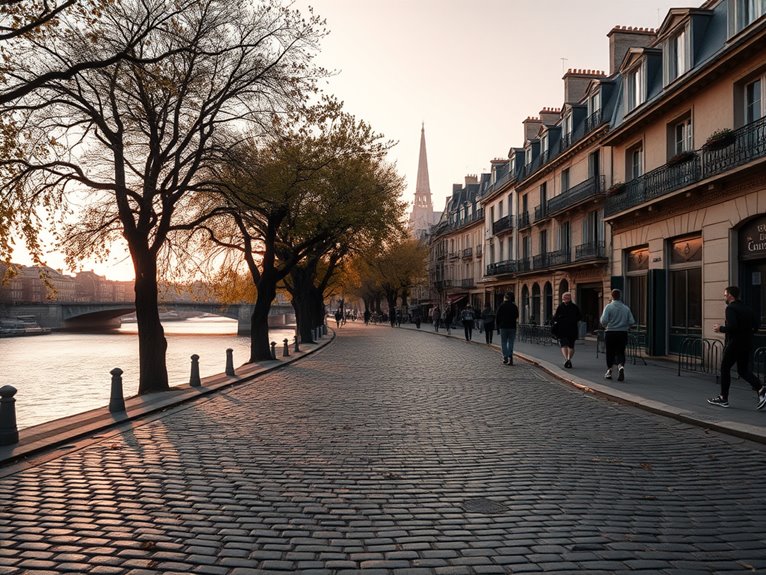
6 Scenic Running Routes Through Paris
I've discovered six spectacular running routes in Paris that'll transform your workout into a sightseeing adventure! Start with the Seine River Trail's 10km loop, then explore Luxembourg Gardens' peaceful paths, venture through Bois de Boulogne's vast park system, tackle Montmartre's challenging hills, meander along Canal Saint-Martin's waterfront, or jog the iconic Golden Axis from Tuileries to the Arc de Triomphe. These routes combine fitness with French culture, and each path holds its own unique surprises.
Seine River Trail: Left Bank to Right Bank
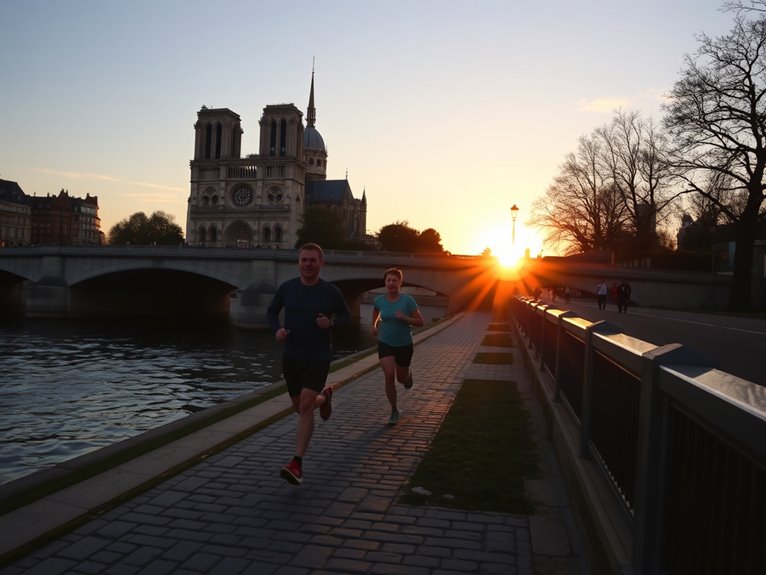
Running along the Seine River in Paris offers one of the most culturally rich and visually stunning urban running experiences in the world. This iconic route takes runners past world-famous monuments, historic bridges, and charming houseboats while providing a relatively flat terrain perfect for runners of all levels. The Left Bank to Right Bank circuit combines the best of both riverbanks, allowing athletes to experience the distinct character of each side of the Seine.
The 10-kilometer circular route transforms from the scholarly Left Bank, home to the historic Latin Quarter and literary cafes, to the grandiose Right Bank with its royal palaces and magnificent museums. Runners can customize their distance by choosing various bridge crossing points, making this route adaptable for both casual joggers and serious athletes training for marathons.
Quick Facts:
- Best running times: Early morning (6-8 AM) or evening (8-10 PM)
- Distance options: 5-15 km (depending on chosen bridges)
- Surface type: Mostly paved paths with some cobblestone sections
- Elevation: Minimal (mostly flat with slight inclines at bridges)
- Water fountains: Available April-October
- Restroom facilities: Limited but available at major tourist spots
- Safety: Well-lit and populated areas, police presence common
Starting Point: Pont des Arts
The wooden-planked Pont des Arts provides an excellent starting point, offering immediate views of the Louvre and Institut de France. Located at 48.858373, 2.337644, this pedestrian bridge connects to both riverside paths and provides easy access to public transportation. Insider tip: Start your run 30 minutes before sunrise to catch the golden light hitting the Seine's surface while avoiding tourist crowds.
Left Bank Segment
Following the Quai de Conti eastward, runners pass the iconic Pont Neuf and Notre-Dame Cathedral. This 4-kilometer stretch features wide paths separated from vehicle traffic and provides consistent shade during morning runs. Local insight: Hidden stairs near Pont de l'Archevêché lead to a lesser-known viewing platform perfect for stretching breaks.
Right Bank Return
Crossing to the Right Bank via Pont Marie, runners encounter the transformed industrial ports now serving as cultural spaces. This section passes the Hôtel de Ville and Louvre Museum, offering slightly wider running paths than the Left Bank. Secret tip: A small garden behind the Orangerie Museum provides a peaceful rest stop with drinking fountains rarely used by tourists.
Pro Tips:
The ideal running experience combines timing and route planning. Run counter-clockwise to maximize river views and minimize intersection crossings. During summer months, start before 7 AM to avoid both heat and crowds. Carry a small water bottle despite available fountains, as some may be under maintenance. Photography enthusiasts should plan their runs during "blue hour" (just before sunrise) when the city lights still twinkle but natural light begins to illuminate historic facades.
Practical Considerations:
Runners should wear visible clothing for early morning or evening runs, as some sections of the path have minimal lighting. While the route is generally well-maintained, watch for occasional loose cobblestones, especially after rain. Download an offline map, as cellular service can be spotty in some underpasses. Several bike-sharing stations along the route offer an alternative return option if needed, and numerous cafés open early for post-run refreshments.
Luxembourg Gardens and Latin Quarter Loop
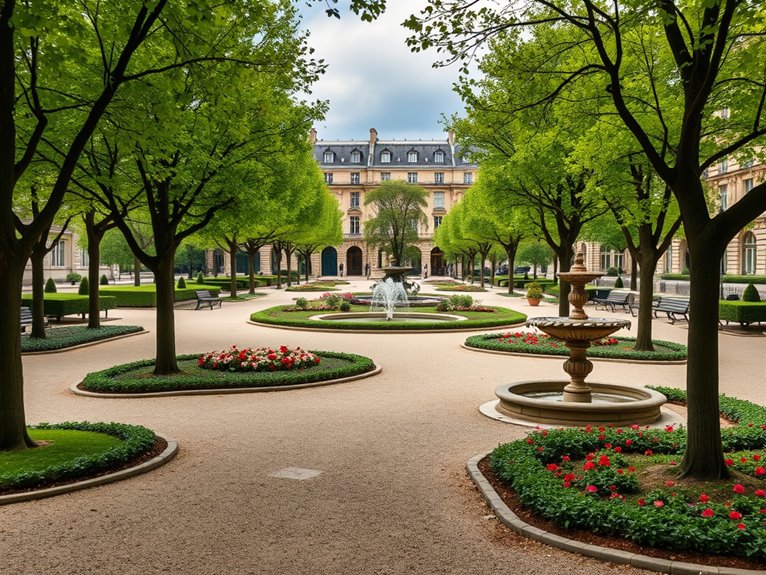
Running through the storied streets of Paris's Latin Quarter and the majestic Luxembourg Gardens offers an unparalleled blend of urban exploration and natural beauty. This 5-kilometer loop combines the serenity of one of Paris's most beautiful parks with the historic charm of the Latin Quarter's medieval streets, allowing runners to experience both the city's cultural heritage and its green spaces in a single route.
This running route has become a favorite among both locals and visitors, thanks to its versatile terrain, abundant landmarks, and year-round accessibility. Runners can enjoy the perfectly manicured paths of Luxembourg Gardens, pass by the iconic Panthéon, and wind through narrow cobblestone streets that have inspired writers and artists for centuries.
Quick Facts:
- Distance: 5 kilometers (3.1 miles)
- Elevation: Minimal (30m total elevation gain)
- Surface: Mixed (gravel paths and sidewalks)
- Best Time: Early morning (6:00-8:00 AM)
- Water Sources: Fountains in Luxembourg Gardens
- Restrooms: Available in Luxembourg Gardens
- Safety: Well-lit and populated route
- Difficulty Level: Moderate, suitable for all running levels
Luxembourg Gardens Section:
The route begins at the north entrance of Luxembourg Gardens, where runners can enjoy wide, crushed-gravel paths that circle the central fountain. The gardens open at sunrise, offering peaceful morning moments before the crowds arrive. The western path provides shade from century-old chestnut trees, while the eastern side offers views of the Luxembourg Palace. Insider tip: The lesser-known southeast corner features a quiet apple orchard, perfect for post-run stretching.
Latin Quarter Loop:
Exiting the gardens' eastern gate, the route winds past the Panthéon and through the heart of the Latin Quarter. This section includes passing the historic Sorbonne University and charming Place de la Contrescarpe. The narrow Rue Mouffetard provides a glimpse into local life, with early-morning market vendors setting up their stalls. Insider tip: The slight incline on Rue Soufflot offers the best sunrise views of the Panthéon.
Pro Tips:
Running this route counter-clockwise provides the best progression of views and minimizes street crossings. Time your run to reach Luxembourg Gardens as it opens (times vary by season) to experience the park at its most serene. During summer months, the eastern paths of the gardens provide more shade during morning runs, while winter runners should stick to the western side for better sun exposure and warmth.
Practical Considerations:
Cobblestones in the Latin Quarter can be slippery when wet, so wear appropriate footwear with good grip. The gardens' gates can occasionally open a few minutes late, so plan accordingly and use this time for warm-up exercises near the entrance. Many cafés along the route open early, making it easy to incorporate a post-run coffee stop into your routine. Remember that the gardens have strict rules about staying on designated paths and respecting closed areas.
Bois De Boulogne Park Circuit
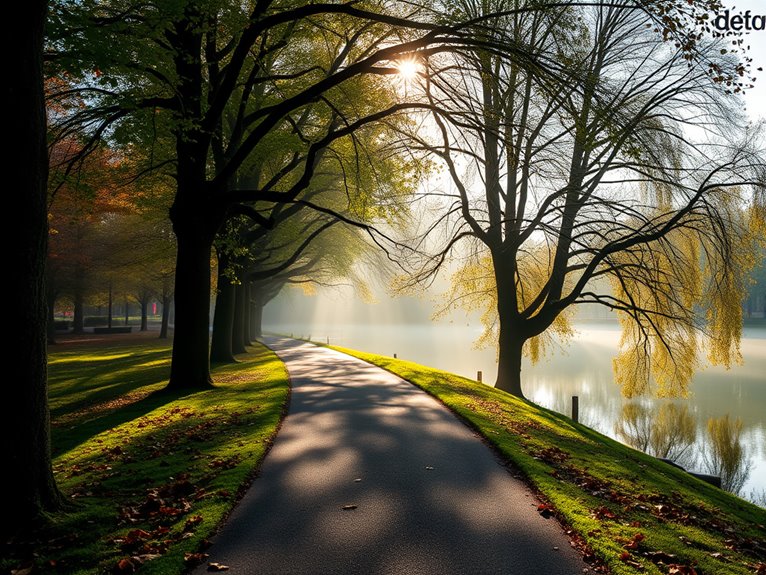
The Bois de Boulogne Park Circuit stands as one of Paris's most cherished running destinations, offering runners a sprawling 846-hectare escape from the urban bustle. This former royal hunting ground has transformed into a verdant paradise where tree-lined paths wind through lakes, gardens, and hidden grottos, providing an unparalleled natural running experience within city limits.
Runners of all levels flock to this western Paris gem for its diverse terrain and multiple circuit options, ranging from gentle 3km loops to challenging 15km routes. The park's well-maintained trails, combined with its rich historical significance and botanical variety, create an engaging running environment that changes character with each season.
Quick Facts:
- Best running hours: 6:00 AM – 10:00 PM daily
- Difficulty levels: Beginner to advanced
- Surface types: Mixed (packed dirt, gravel, paved paths)
- Water fountains: Available every 2-3 km
- Restroom facilities: Located near major entrances
- Safety considerations: Well-lit until sunset; run with partners after dark
- Nearest metro stations: Porte Dauphine, Les Sablons
- Parking: Available at multiple entrance points
The Main Circuit (8km Loop)
The signature running route circles the park's perimeter, offering a relatively flat terrain ideal for consistent pace-setting. This well-marked path passes the famous Longchamp Racecourse and provides stunning views of the Hippodrome de Longchamp. Insider tip: The lesser-known eastern path parallel to Avenue Foch offers shade and fewer cyclists during peak hours.
The Lakes Circuit (5km)
A picturesque route connecting the park's two lakes – Lac Inférieur and Lac Supérieur. This trail features wooden bridges and waterside paths, perfect for interval training. The route includes several dirt trails that are gentler on joints than paved surfaces. Hidden gem: A secret meditation garden near the Grand Cascade provides a peaceful stretch break point.
Pro Tips:
The ideal running experience comes during early morning hours (6:00-8:00 AM) when the air is crisp and paths are least crowded. For long-distance training, combine the main circuit with smaller loops around the lakes to create custom distances. The park's northwestern section offers the most challenging elevation changes, perfect for hill training.
Practical Considerations:
Carry a basic map or download the park's running paths beforehand, as mobile reception can be spotty in some areas. Water fountains are most reliable from April through October; during winter months, bring your own hydration. The park hosts various running groups and weekly organized runs – check bulletin boards near main entrances for schedules and meetup points.
Montmartre Hills Challenge

Running through Montmartre offers an exhilarating combination of intense cardio workout and cultural immersion in one of Paris's most artistic neighborhoods. The steep inclines and countless stairs that characterize this historic district provide runners with a challenging urban terrain while surrounding them with stunning views of the French capital.
This iconic hilltop district, rising 130 meters above sea level at its highest point, transforms an ordinary running session into an adventurous journey through narrow cobblestone streets, past historic windmills, and around the magnificent Sacré-Cœur Basilica. The route's varying elevations and architectural diversity make it an ideal training ground for runners looking to build both endurance and strength.
Quick Facts:
- Distance: 5-7 km (depending on chosen route variations)
- Elevation gain: 130 meters
- Best running times: Early morning (6-8 AM) or evening (after 8 PM)
- Required gear: Well-cushioned running shoes with good grip
- Difficulty level: Moderate to challenging
- Water fountains: Located at Place Saint-Pierre and near Sacré-Cœur
- Seasonal availability: Year-round, but extra caution needed on wet cobblestones
The Classic Montmartre Circuit starts at Place des Abbesses, taking runners past the famous "I Love You Wall" before ascending the steep Rue des Saules. This segment includes the iconic La Maison Rose café and the last remaining vineyard in Paris, Clos Montmartre. The challenging ascent offers multiple photo opportunities and strategic rest points disguised as cultural stops.
The Stairs Challenge incorporates the famous steps leading to Sacré-Cœur Basilica, offering an intense leg workout while providing breathtaking views of Paris. Runners can choose between the main staircase (222 steps) or discover lesser-known side stairs for a more secluded experience. The steps are well-lit and maintained, making them suitable for early morning or evening runs.
The Windmills Loop takes runners past the historic Moulin de la Galette, connecting to Rue Lepic's spiral ascent. This section features gradient changes that naturally facilitate interval training, with the vintage windmills serving as memorable landmarks for pace-setting and recovery points.
Pro Tips:
Early risers will find the neighborhood practically empty before 8 AM, making it ideal for uninterrupted training. Photographers should plan their runs during the "golden hour" just after sunrise when the light creates magical effects on the white dome of Sacré-Cœur. Consider breaking the run into segments, using landmarks as interval markers, and incorporating the various staircases strategically throughout your workout.
Practical Advice:
Map your route in advance and download it offline, as the winding streets can be confusing. Carry a small water bottle despite the available fountains, and wear layers as the hilltop can be considerably cooler and windier than the rest of Paris. Consider starting at the Abbesses or Anvers metro stations, both offering convenient access points to begin your Montmartre running challenge.
Canal Saint-Martin Waterfront Path
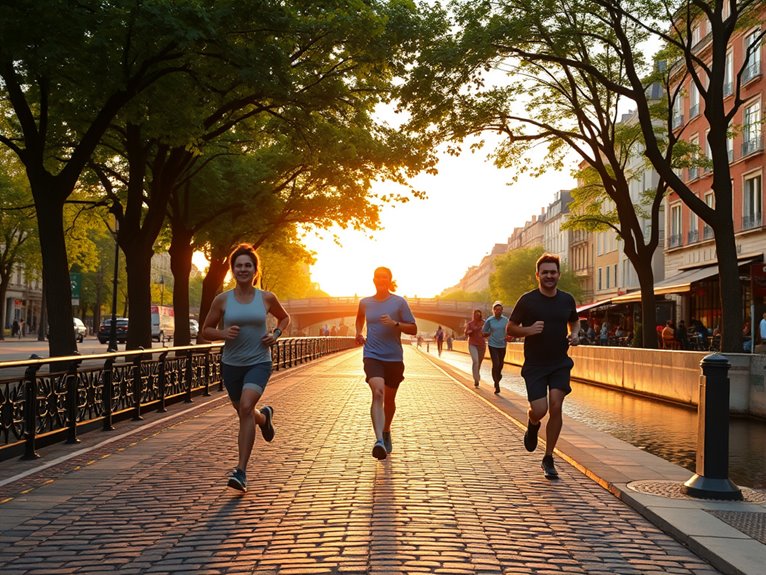
The Canal Saint-Martin offers runners a picturesque 4.5-kilometer urban waterway experience, combining historic 19th-century architecture with vibrant street art and local culture. This flat, well-maintained path weaves through one of Paris's trendiest neighborhoods, providing a unique blend of industrial heritage and modern city life that makes every run both scenic and culturally enriching.
Running along this historic waterway, constructed under Napoleon Bonaparte in 1802, presents countless Instagram-worthy moments, from iconic iron footbridges to tree-lined quays. The route's gentle grade and multiple access points make it suitable for runners of all levels, while the numerous cafés and resting spots along the way provide perfect cool-down opportunities after your workout.
Quick Facts:
- Best running times: Early morning (6-8 AM) or evening (7-9 PM)
- Total distance: 4.5 km one-way
- Surface type: Mixed (cobblestone and paved paths)
- Water fountains: Available every 800 meters
- Lighting: Well-lit until midnight
- Safety: High, with regular police patrols
- Difficulty level: Easy to moderate
- Bathroom facilities: Limited public access
The Northern Section (République to Stalingrad):
Starting at Place de la République, this section features wider paths and fewer crowds, making it ideal for interval training. The northern stretch offers excellent views of converted warehouses and modern architecture, with several bridge crossings that can be incorporated into your route for variety. Look for the hidden street art beneath the Bridge 3 overpass – a local secret that changes regularly.
The Southern Section (République to Bastille):
The lower portion provides a more intimate running experience, with narrower paths and charming locks to observe. This section goes underground for a portion, offering a unique tunnel running experience. Time your run to catch the lock operations, typically occurring between 10 AM and 5 PM, when boats navigate through the system.
Pro Tips:
The canal path is best enjoyed during sunrise runs when the morning light creates stunning reflections on the water, and fewer pedestrians occupy the space. Consider incorporating the nine locks along the route as natural interval markers for training purposes. For a longer run, connect with the Bassin de la Villette at the northern end, which adds another 2 kilometers to your route.
Practical Advice:
Wear shoes with good grip, as some sections of the path can be slippery, especially after rain. The cobblestone sections require attention to foot placement. Carry a small water bottle despite the presence of fountains, as some may be under maintenance. During summer months, the path can get crowded after 10 AM, particularly on weekends, so plan your runs accordingly. Several bike rental stations along the route offer an alternative way to explore the canal on rest days.
Tuileries Garden to Champs-Élysées Route
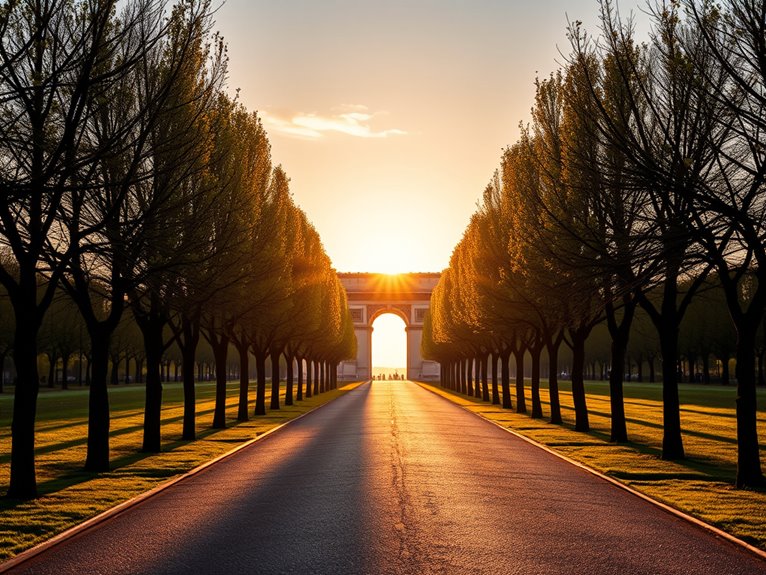
Running through the heart of Paris from the Tuileries Garden to the Champs-Élysées offers an unparalleled blend of historical grandeur and urban energy. This iconic 3-kilometer route takes runners past some of the city's most prestigious landmarks, including the Louvre Museum, Place de la Concorde, and the Arc de Triomphe, while providing a smooth, well-maintained path perfect for both serious runners and casual joggers.
The route's architectural splendor is matched by its practical running attributes, featuring wide pathways, minimal street crossings, and plenty of water fountains along the way. Whether bathed in early morning light or illuminated by evening streetlamps, this running path delivers a quintessentially Parisian experience that transforms a regular workout into an unforgettable journey through the city's golden axis.
Quick Facts:
- Best running times: 6:00-8:00 AM or 9:00-10:00 PM
- Distance: 3 kilometers one-way (can be extended)
- Terrain: Mainly flat, gravel and paved surfaces
- Water fountains: Available every 500 meters
- Restroom facilities: Located in Tuileries Garden and near Arc de Triomphe
- Safety: Well-lit and patrolled route
- Seasonal considerations: Busiest during summer tourist season (July-August)
Starting Point: Tuileries Garden
Begin at the eastern entrance near the Louvre Museum. The garden opens at 7:00 AM in summer and 7:30 AM in winter. The crushed gravel paths provide excellent shock absorption, and the formal French garden layout offers multiple route options. Insider tip: The north alley tends to be less crowded than the central pathway.
Mid-Route: Place de la Concorde
After exiting the Tuileries, cross Place de la Concorde via the designated pedestrian crossings. This massive square offers stunning views of the Eiffel Tower to the west and the Madeleine Church to the north. Insider tip: Time your crossing with the traffic lights to maintain running rhythm.
Final Stretch: Champs-Élysées
The broad sidewalks of the Champs-Élysées provide ample running space. The slight incline towards the Arc de Triomphe adds a challenging finish to your run. The avenue is lined with trees offering occasional shade. Insider tip: Run on the north side in the morning and the south side in the evening to avoid direct sunlight.
Pro Tips:
For the best running experience, tackle this route during the earliest morning hours when tourist crowds are minimal and the air is crispest. Weekday mornings are particularly peaceful, offering prime photo opportunities without the usual throng of visitors. Consider running this route in reverse (starting at the Arc de Triomphe) to take advantage of the slight downhill gradient and save energy for exploring other parts of the city afterward.
Practical Advice:
Carry a small water bottle despite the available fountains, as some may be under maintenance. Wear reflective gear if running during dawn or dusk, and always carry a phone and basic ID. The route can be easily modified to create loops or extended runs by incorporating nearby areas like the Seine River banks or the Champ de Mars. Local running groups often meet at the Tuileries Garden entrance at 7:00 AM on weekends, providing an opportunity to join fellow runners and gain local insights.
